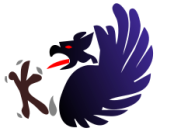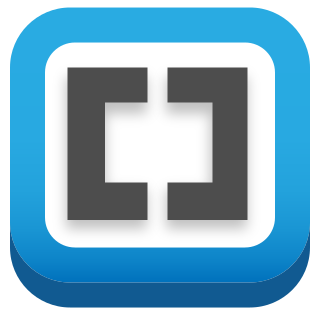In information and communications technology, a Request for Comments (RFC) is a type of publication from the technology community. RFCs may come from many bodies including from the Internet Engineering Task Force (IETF), the Internet Research Task Force (IRTF), the Internet Architecture Board (IAB) or from independent authors. The RFC system is supported by the Internet Society (ISOC).

A website or Web site is a collection of related network web resources, such as web pages, multimedia content, which are typically identified with a common domain name, and published on at least one web server. Notable examples are wikipedia.org, google.com, and amazon.com.
In HTML and XHTML, an image map is a list of coordinates relating to a specific image, created in order to hyperlink areas of the image to different destinations. For example, a map of the world may have each country hyperlinked to further information about that country. The intention of an image map is to provide an easy way of linking various parts of an image without dividing the image into separate image files.
An HTML editor is a program for editing HTML, the markup of a web page. Although the HTML markup in a web page can be controlled with any text editor, specialized HTML editors can offer convenience and added functionality. For example, many HTML editors handle not only HTML, but also related technologies such as CSS, XML and JavaScript or ECMAScript. In some cases they also manage communication with remote web servers via FTP and WebDAV, and version control systems such as Subversion or Git. Many word processing, graphic design and page layout programs that are not dedicated to web design, such as Microsoft Word or Quark XPress, also have the ability to function as HTML editors.

UltraEdit is a commercial text editor for Microsoft Windows, Linux and OS X created in 1994 by the founder of IDM Computer Solutions Inc., Ian D. Mead. The editor contains tools for programmers, including macros, configurable syntax highlighting, code folding, file type conversions, project management, regular expressions for search-and-replace, a column-edit mode, remote editing of files via FTP, interfaces for APIs or command lines of choice, and more. Files can be browsed and edited in tabs, and it also supports Unicode and hex editing mode.

AOLpress is a discontinued HTML editor that was available from America Online (AOL). It was originally developed as NaviPress by the company NaviSoft before being bought by AOL. It was discontinued in 2000. However, the last version (2.0) may still be found on some Web sites for downloading. AOLpress was rather strict about enforcing legal HTML: when saving edited pages that were created outside AOLpress, code that did not conform to the HTML 3.2 standard and specifications may have been changed to do so. Today, the HTML code used is very outdated and may not display more recent Web sites correctly. It does not support PNG images, and this limits its support on many sites where the newer PNG format has been adopted.
PageMill is a WYSIWYG HTML editor developed by Adobe Systems.

Microsoft Expression Web is an HTML editor and general web design software product by Microsoft. It is available free of charge from Microsoft and is a component of the discontinued Expression Studio.

An online rich-text editor is the interface for editing rich text within web browsers, which presents the user with a "what-you-see-is-what-you-get" (WYSIWYG) editing area. The aim is to reduce the effort for users trying to express their formatting directly as valid HTML markup.
HoTMetaL is an early commercial HTML-authoring software program, released in 1994 by SoftQuad Software of Toronto, Canada.
EmEditor is a lightweight extensible commercial text editor for Microsoft Windows. It was developed by Yutaka Emura of Emurasoft, Inc. It includes full Unicode support, 32-bit and 64-bit builds, syntax highlighting, find and replace with regular expressions, vertical selection editing, editing of large files, and is extensible via plugins and scripts.

KompoZer was an open source WYSIWYG HTML editor based on the now-discontinued Nvu editor. KompoZer is maintained as a community-driven fork, and is a project on Sourceforge.
The Web Hypertext Application Technology Working Group (WHATWG) is a community of people interested in evolving HTML and related technologies. The WHATWG was founded by individuals from Apple Inc., the Mozilla Foundation and Opera Software, leading Web browser vendors, in 2004. Since then, the editor of the WHATWG specifications, Ian Hickson, has moved to Google.
Thakur Vishva Narain Singh was the first Braille editor of India and an eminent journalist. He served as Braille editor in the publication section of the National Institute of Visually Handicapped in Dehra Dun. After his retirement, he continued to write and worked with local dailies in the city.
Aloha Editor is an open-source WYSIWYG editor, written in JavaScript, that can be used in webpages. Aloha Editor aims to be easy to use and fast in editing, and allows advanced inline editing. The first version was released 15 July 2010.

BlueGriffon is a WYSIWYG content editor for the World Wide Web. It is based on the discontinued Nvu editor, which in turn is based on the Composer component of the Mozilla Application Suite. Powered by Gecko, the rendering engine of Firefox, it can edit Web pages in conformance to Web Standards. It runs on Microsoft Windows, macOS and Linux.

tkWWW is an early, now discontinued web browser and WYSIWYG HTML editor written by Joseph Wang at MIT as part of Project Athena and the Globewide Network Academy project. The browser was based on the Tcl language and the Tk (toolkit) extension but did not achieve broad user-acceptance or market share, although it was included in many Linux distributions by default. Joseph Wang wanted tkWWW to become a replacement for r r n and to become a "swiss army knife" of networked computing.
Starborn is a fictional character, a superhero that appears in comic books published by Boom! Studios. The character was created by writer-editor Stan Lee with Chris Roberson and Khary Randolph. The character first appeared in Starborn #1.

Brackets is a source code editor with a primary focus on web development. Created by Adobe Systems, it is free and open-source software licensed under the MIT License, and is currently maintained on GitHub by Adobe and other open-sourced developers. It is written in JavaScript, HTML and CSS. Brackets is cross-platform, available for macOS, Windows, and most Linux distributions. The main purpose of brackets is its live HTML, CSS and JavaScript editing functionality.







